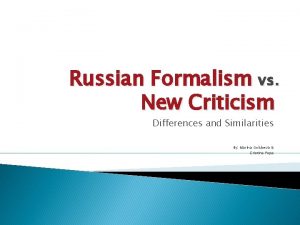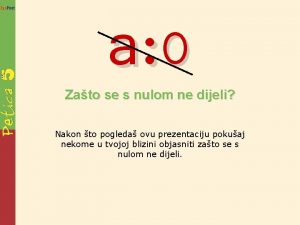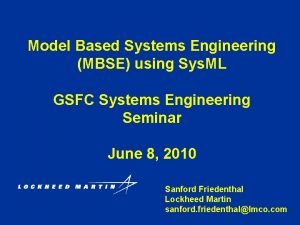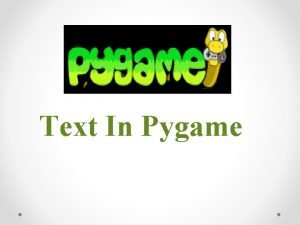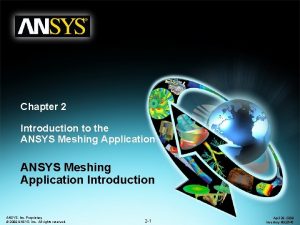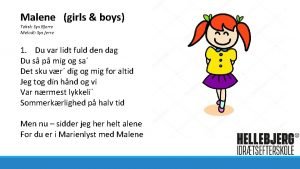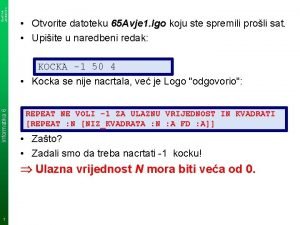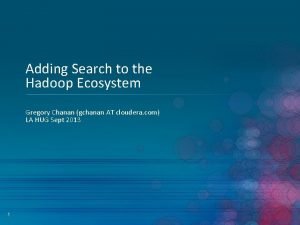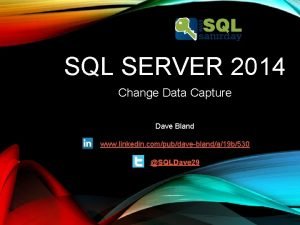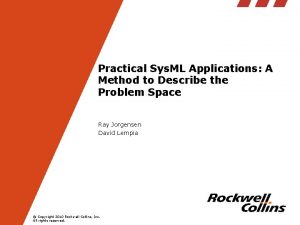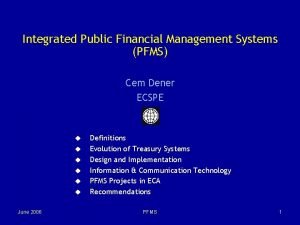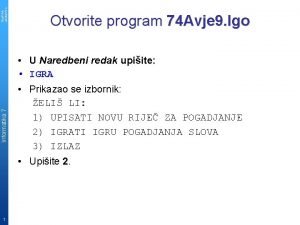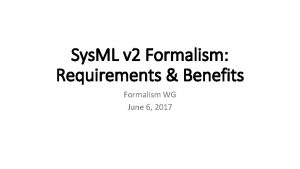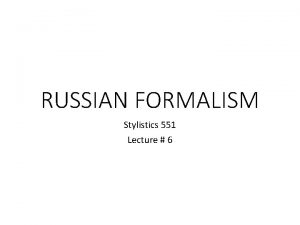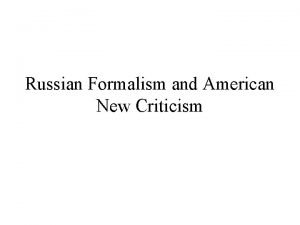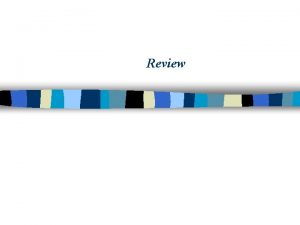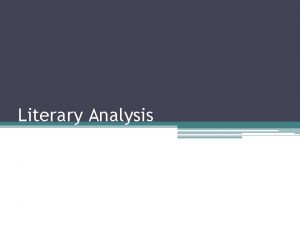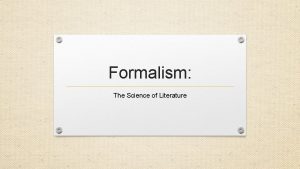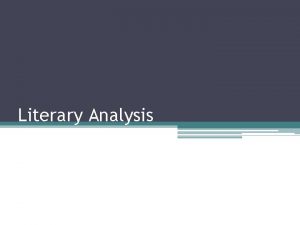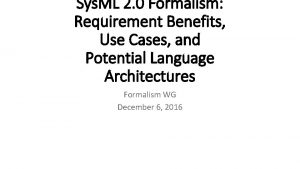Sys ML v 2 Formalism Requirements Formalism WG




















- Slides: 20

Sys. ML v 2 Formalism Requirements Formalism WG September 15, 2016

Overview • Driving Requirements • Background on Formalism • Formalism Requirements

Overview • Driving Requirements • Background on Formalism • Formalism Requirements

Driving Requirements • Specification shall – Include precise semantics that reduces ambiguity and enables concise representation of the concepts. – Derive language from a well-specified logical formalism that can leverage the model for a broad range of analysis and model checking.

Analysis and Model Checking • Broad range of analysis and model checking, including: – Validating that the model is logically consistent, answering questions such as the impact of a requirement or design change, or assess how a failure could propagate through a system. – Enabling integration with a diverse range of equation solvers, provers, and execution environments, including for quantitative data.

Overview • Driving Requirements • Background on Formalism • Formalism Requirements

Language = Syntax + Semantics + Vocabulary • Syntax – Concrete: What you see (rectangles, lines, text). – Abstract: What you say (“block”, “item flow”) – Interchange/API: What computers read/write. • Semantics – What’s possible to conclude about the things being modeled when using the syntax. • Vocabulary (libraries) – Predefined syntactic (modeling) elements. 7

Language Specifications Language Specification Syntax Concrete Graphical Textual Abstract Interchange/ API Semantics Operational Declarative Vocabulary / Libraries Application Independent Application Dependent Model Theoretic / Denotational 8

Overview • Driving Requirements • Background on Formalism • Formalism Requirements

Requirements (General) • Uniform syntactic interpretation – Everyone looking at Sys. ML diagrams should • Describe them the same way (using Sys. ML terminology). • Agree on whether they are“legal” Sys. ML (well-formedness). • Uniform semantic interpretation – Everyone looking at Sys. ML diagrams should • Reach the same conclusions about the things being modeled. • Including whether it is possible to draw any conclusions at all (consistency). 10

Who’s “Everyone”? • Modelers, teachers, consultants, spec writers. – They understand each others’ models the way the authors intended. • Modeling tool builders – Their tools instantiate abstract syntax the same way (MIWG) for all diagrams. • Analysis tool builders – Their tools produce same results for all instances of abstract syntax. 11

Syntactic Requirements (Specific) • Abstract syntax and library specifications – Shall be notation-independent. • Concrete syntax specification – Shall include model and interchange/API for diagram/text information that is not included in abstract syntax, but linked to abstract syntax (eg, DD’s DI/DG). – All examples shall be accompanied by a model for them, as above. 12

Semantic Requirements (Specific) • Semantics shall be: – expressed in mathematical logic – or a translation to mathematical logic. • Semantics shall be modelled: – Shall include domain-independent model libraries. – Abstract syntax shall specify patterns of (automatically) using library elements with instances of abstract syntax. 13

Mathematical Logic Example UML Generalization From UML 2. 5 Specification: Vehicle Car “Every instance of car is an instance of vehicle” How can this be specified more precisely?

Mathematical Logic Example OWL Sub. Classof subset of Vehicles Sub. Class. Of(Car, Vehicle) Cars From OWL 2 Direct Semantics: CE denotes a class expression; ⋅ C is the class interpretation function that assigns to each class C ∈ VC a subset (C)C ⊆ ΔI = a thing

Modeling Semantics Example act Take. Picture Modelers see: Modelers mean: Focus Shoot “Focus before shooting when taking a picture” How do tool (builder)s know that?

Modeling Semantics Example bdd Sys. ML Model Library Sys. ML provides a library of temporal relations… …and specifies how tools use it when instantiating the metamodel: «activity» Activity Occurrence happens During happens. Before «activity» Take. Picture step 1 : Focus : happens. Before step 2 : Shoot

Semantic and Syntactic Requirements (Specific) • Where Sys. ML v 2 is extensible, semantics and syntax shall also be extensible.

Formalism Requirements: Semantics: 1) Sys. ML v 2 shall have at least a declarative semantics expressed in mathematical logic or have a translation to mathematical logic. (Definition: Classically, mathematical logic is considered to be made up of set theory, model theory, recursion theory, proof theory, and construction mathematics (constructivism). In addition, we are also considering category theory and type theory. ) Example 2) Semantics shall be modelled; specifically, Sys. ML v 2 shall include domain-independent model libraries, and abstract syntax shall specify patterns of (automatically) using them with instances of abstract syntax. Abstract Syntax: 1) The Sys. ML v 2 abstract syntax shall be independent of notation. Concrete Syntax: 1) Any Sys. ML v 2 concrete syntax shall include a model and interchange format/API for diagram/text information that is not included in the abstract syntax, but is linked to the abstract syntax (e. g. , DD’s DI/DG). 2) All examples of concrete syntax in the specification shall be accompanied by a model for them, as above. Semantics and Syntax: 1) If Sys. ML v 2 is extensible, the syntax and semantics shall both be extensible.

Questions / Comments?
 Structuralist/formalist similarities and differences
Structuralist/formalist similarities and differences Sys print
Sys print Sys ml
Sys ml Pygame default font
Pygame default font Application
Application Min lejlighed er lidt brændt ned
Min lejlighed er lidt brændt ned Parnas
Parnas Infolight
Infolight Pentium iv
Pentium iv Td sysml corrigé
Td sysml corrigé Sys print
Sys print Sys log to cloudera
Sys log to cloudera Cdc sql server 2014
Cdc sql server 2014 Sys bjerre
Sys bjerre Parnas sys
Parnas sys Cem dener
Cem dener Import sys
Import sys Skl key
Skl key Sys print informatika
Sys print informatika /sys/class/gpio/gpiochip
/sys/class/gpio/gpiochip Sys.indexes
Sys.indexes
